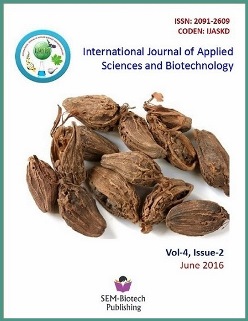Foraging Behavior of Native Honeybee (Apis Cerana F.) and European Honeybee (Apis Mellifera L.) on Flowers of Common Buckwheat (Fagopyrum Esculentum M.) in Chitwan, Nepal
DOI:
https://doi.org/10.3126/ijasbt.v4i2.15131Keywords:
Apis cerana F., A. mellifera L., foraging, buckwheatAbstract
This paper is the findings of the research conducted on foraging behavior of Native honeybee (Apis cerana F.) and European honeybee (Apis mellifera L.) on flowering buckwheat (Fagopyrum esculentum Moench) inside the cage during November 2012 to 2013 at Meghauli, Chitwan, Nepal. Apis cerana F. started their foraging activities early in the morning (8.24 ± 0.50 AM) and ceased late in the evening (5.18 ± 0.20 PM) in comparison to Apis mellifera L., which started foraging at 8.29 ± 0.50 AM and ceased at 4.56 ± 0.50 PM. The total duration of foraging per day was more in Apis cerana F. than Apis mellifera L., i.e. 8.34 ± 0.90 hours per day in Apis cerana F. and 8.25 ± 0.90 hours per day in Apis mellifera L. That means A. cerana F. was 1.8% more efficient on foraging duration than A. mellifera L. Similarly, the number of Apis cerana F. and Apis mellifera L. entering into the hive in five minutes was the highest (51.69 ± 0.45 in Apis cerana F., and 62.81 ± 0.45 in Apis mellifera L.) at 12 Noon while lowest (11.24 ± 0.11 in Apis cerana F., and 5.89 ± 0.11 in Apis mellifera L.) at 5 PM and no activity was started at 8 AM. Likewise, the number of Apis cerana F. and Apis mellifera L. bees outgoing from the hive in five minutes was the highest (42.67 ± 0.98 in Apis cerana F. and 48.71 ± 0.98 in Apis mellifera L.) at 12 Noon and the lowest (4.31 ± 0.07 in Apis cerana F. and 2.39 ± 0.07 in Apis mellifera L.) at 5 PM. The number of buckwheat flower visited by Apis cerana F. was highest at 10 AM while by Apis mellifera L. it was highest at 12 Noon. But, for both species of honeybees it was lowest at 4 PM. There was more time spent by Apis mellifera L. (2.37 seconds) per flower than Apis cerana F. (1.95 seconds) during floral visit. So, Apis cerana F is efficient in foraging and hence in pollination on buckwheat than Apis mellifera L suggesting buckwheat cultivation along with bee farming especially Apis cerana F.
Int J Appl Sci Biotechnol, Vol 4(2): 236-239




